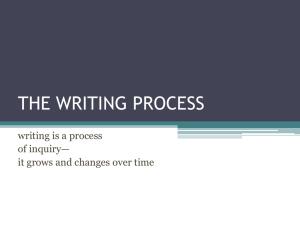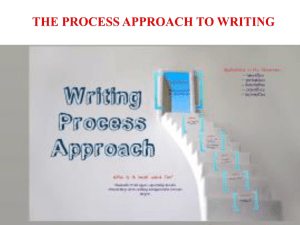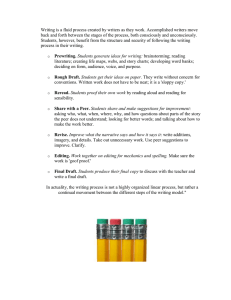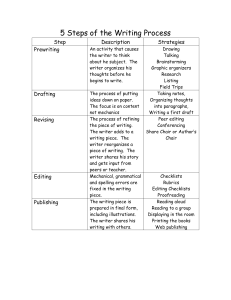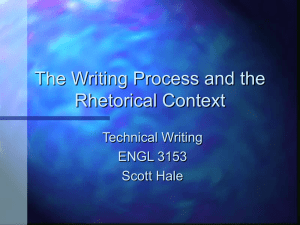Rules for Writing Workshop
advertisement
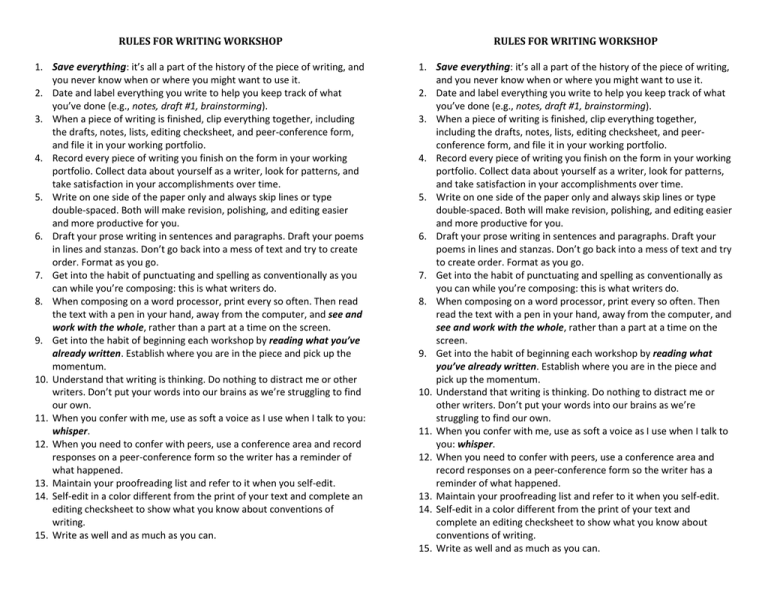
RULES FOR WRITING WORKSHOP RULES FOR WRITING WORKSHOP 1. Save everything: it’s all a part of the history of the piece of writing, and you never know when or where you might want to use it. 2. Date and label everything you write to help you keep track of what you’ve done (e.g., notes, draft #1, brainstorming). 3. When a piece of writing is finished, clip everything together, including the drafts, notes, lists, editing checksheet, and peer-conference form, and file it in your working portfolio. 4. Record every piece of writing you finish on the form in your working portfolio. Collect data about yourself as a writer, look for patterns, and take satisfaction in your accomplishments over time. 5. Write on one side of the paper only and always skip lines or type double-spaced. Both will make revision, polishing, and editing easier and more productive for you. 6. Draft your prose writing in sentences and paragraphs. Draft your poems in lines and stanzas. Don’t go back into a mess of text and try to create order. Format as you go. 7. Get into the habit of punctuating and spelling as conventionally as you can while you’re composing: this is what writers do. 8. When composing on a word processor, print every so often. Then read the text with a pen in your hand, away from the computer, and see and work with the whole, rather than a part at a time on the screen. 9. Get into the habit of beginning each workshop by reading what you’ve already written. Establish where you are in the piece and pick up the momentum. 10. Understand that writing is thinking. Do nothing to distract me or other writers. Don’t put your words into our brains as we’re struggling to find our own. 11. When you confer with me, use as soft a voice as I use when I talk to you: whisper. 12. When you need to confer with peers, use a conference area and record responses on a peer-conference form so the writer has a reminder of what happened. 13. Maintain your proofreading list and refer to it when you self-edit. 14. Self-edit in a color different from the print of your text and complete an editing checksheet to show what you know about conventions of writing. 15. Write as well and as much as you can. 1. Save everything: it’s all a part of the history of the piece of writing, and you never know when or where you might want to use it. 2. Date and label everything you write to help you keep track of what you’ve done (e.g., notes, draft #1, brainstorming). 3. When a piece of writing is finished, clip everything together, including the drafts, notes, lists, editing checksheet, and peerconference form, and file it in your working portfolio. 4. Record every piece of writing you finish on the form in your working portfolio. Collect data about yourself as a writer, look for patterns, and take satisfaction in your accomplishments over time. 5. Write on one side of the paper only and always skip lines or type double-spaced. Both will make revision, polishing, and editing easier and more productive for you. 6. Draft your prose writing in sentences and paragraphs. Draft your poems in lines and stanzas. Don’t go back into a mess of text and try to create order. Format as you go. 7. Get into the habit of punctuating and spelling as conventionally as you can while you’re composing: this is what writers do. 8. When composing on a word processor, print every so often. Then read the text with a pen in your hand, away from the computer, and see and work with the whole, rather than a part at a time on the screen. 9. Get into the habit of beginning each workshop by reading what you’ve already written. Establish where you are in the piece and pick up the momentum. 10. Understand that writing is thinking. Do nothing to distract me or other writers. Don’t put your words into our brains as we’re struggling to find our own. 11. When you confer with me, use as soft a voice as I use when I talk to you: whisper. 12. When you need to confer with peers, use a conference area and record responses on a peer-conference form so the writer has a reminder of what happened. 13. Maintain your proofreading list and refer to it when you self-edit. 14. Self-edit in a color different from the print of your text and complete an editing checksheet to show what you know about conventions of writing. 15. Write as well and as much as you can.
